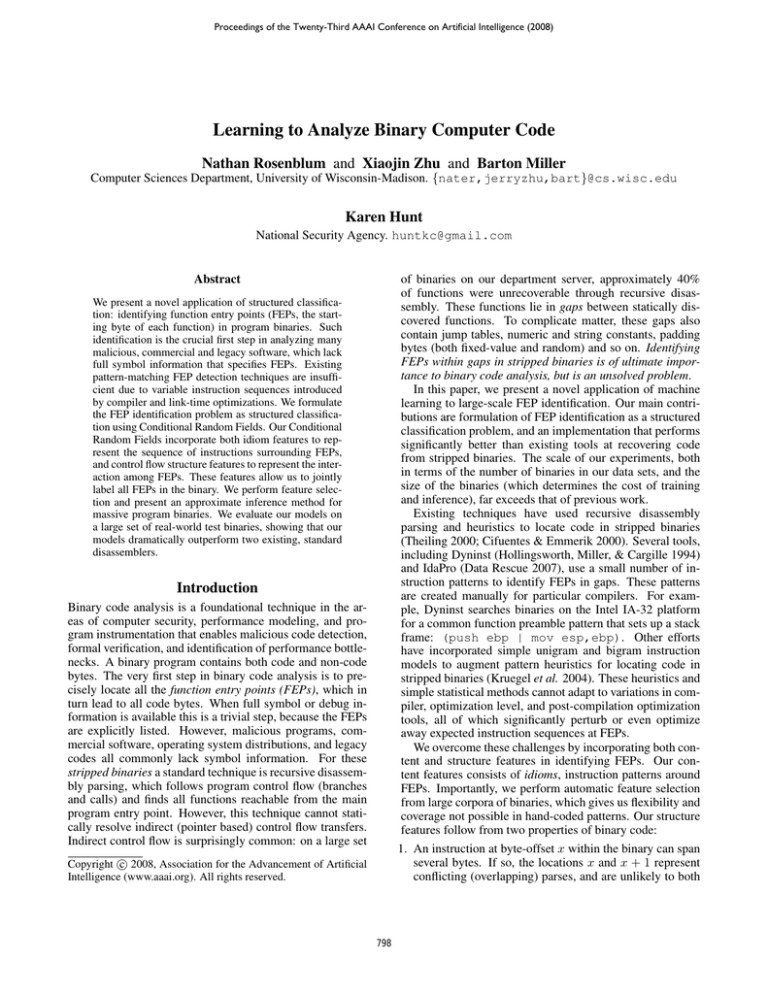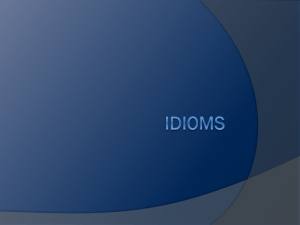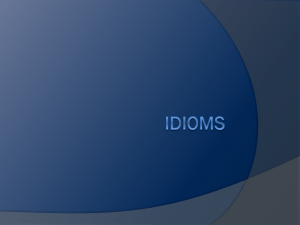
Proceedings of the Twenty-Third AAAI Conference on Artificial Intelligence (2008)
Learning to Analyze Binary Computer Code
Nathan Rosenblum and Xiaojin Zhu and Barton Miller
Computer Sciences Department, University of Wisconsin-Madison. {nater,jerryzhu,bart}@cs.wisc.edu
Karen Hunt
National Security Agency. huntkc@gmail.com
Abstract
of binaries on our department server, approximately 40%
of functions were unrecoverable through recursive disassembly. These functions lie in gaps between statically discovered functions. To complicate matter, these gaps also
contain jump tables, numeric and string constants, padding
bytes (both fixed-value and random) and so on. Identifying
FEPs within gaps in stripped binaries is of ultimate importance to binary code analysis, but is an unsolved problem.
In this paper, we present a novel application of machine
learning to large-scale FEP identification. Our main contributions are formulation of FEP identification as a structured
classification problem, and an implementation that performs
significantly better than existing tools at recovering code
from stripped binaries. The scale of our experiments, both
in terms of the number of binaries in our data sets, and the
size of the binaries (which determines the cost of training
and inference), far exceeds that of previous work.
Existing techniques have used recursive disassembly
parsing and heuristics to locate code in stripped binaries
(Theiling 2000; Cifuentes & Emmerik 2000). Several tools,
including Dyninst (Hollingsworth, Miller, & Cargille 1994)
and IdaPro (Data Rescue 2007), use a small number of instruction patterns to identify FEPs in gaps. These patterns
are created manually for particular compilers. For example, Dyninst searches binaries on the Intel IA-32 platform
for a common function preamble pattern that sets up a stack
frame: (push ebp | mov esp,ebp). Other efforts
have incorporated simple unigram and bigram instruction
models to augment pattern heuristics for locating code in
stripped binaries (Kruegel et al. 2004). These heuristics and
simple statistical methods cannot adapt to variations in compiler, optimization level, and post-compilation optimization
tools, all of which significantly perturb or even optimize
away expected instruction sequences at FEPs.
We overcome these challenges by incorporating both content and structure features in identifying FEPs. Our content features consists of idioms, instruction patterns around
FEPs. Importantly, we perform automatic feature selection
from large corpora of binaries, which gives us flexibility and
coverage not possible in hand-coded patterns. Our structure
features follow from two properties of binary code:
We present a novel application of structured classification: identifying function entry points (FEPs, the starting byte of each function) in program binaries. Such
identification is the crucial first step in analyzing many
malicious, commercial and legacy software, which lack
full symbol information that specifies FEPs. Existing
pattern-matching FEP detection techniques are insufficient due to variable instruction sequences introduced
by compiler and link-time optimizations. We formulate
the FEP identification problem as structured classification using Conditional Random Fields. Our Conditional
Random Fields incorporate both idiom features to represent the sequence of instructions surrounding FEPs,
and control flow structure features to represent the interaction among FEPs. These features allow us to jointly
label all FEPs in the binary. We perform feature selection and present an approximate inference method for
massive program binaries. We evaluate our models on
a large set of real-world test binaries, showing that our
models dramatically outperform two existing, standard
disassemblers.
Introduction
Binary code analysis is a foundational technique in the areas of computer security, performance modeling, and program instrumentation that enables malicious code detection,
formal verification, and identification of performance bottlenecks. A binary program contains both code and non-code
bytes. The very first step in binary code analysis is to precisely locate all the function entry points (FEPs), which in
turn lead to all code bytes. When full symbol or debug information is available this is a trivial step, because the FEPs
are explicitly listed. However, malicious programs, commercial software, operating system distributions, and legacy
codes all commonly lack symbol information. For these
stripped binaries a standard technique is recursive disassembly parsing, which follows program control flow (branches
and calls) and finds all functions reachable from the main
program entry point. However, this technique cannot statically resolve indirect (pointer based) control flow transfers.
Indirect control flow is surprisingly common: on a large set
1. An instruction at byte-offset x within the binary can span
several bytes. If so, the locations x and x + 1 represent
conflicting (overlapping) parses, and are unlikely to both
c 2008, Association for the Advancement of Artificial
Copyright Intelligence (www.aaai.org). All rights reserved.
798
be FEPs;
Binary Code Bytes
2. The disassembly starting from x can contain a call instruction that calls offset x0 . If we believe that x is an FEP,
then x0 probably is too.
By using both content and structure features, we are able
to identify FEPs in gaps with significantly higher accuracy
than existing techniques.
The remainder of this paper is structured as follows. We
first describe characteristics of binary code that influence the
way we design and implement our classifier. We present a
“flat” model with content features, where FEP classification
is done individually, and describe feature selection. We then
add structure features to form a “structured” model, where
FEP classification is done jointly. We describe an efficient
approximation to inference in the resulting large graphical
model. We evaluate our models on several large real-world
data sets of Linux and Windows binaries, and compare them
against existing tools.
14
53
83
ec
0c
8b
5c
24
14
8b
53
04
8b
0b
add 14,esp
sub c,esp
push ebx
sub c,esp
or 8b,al
mov 14(esp),
ebx
mov 14(esp),
ebx
pop esp
mov 4(ebx),
edx
mov 4(ebx),
edx
mov 4(ebx),
edx
mov (ebx),ecx
mov (ebx),ecx
mov (ebx),ecx
and 14,al
Disassembled Instruction Sequences
Figure 1: Self-repairing disassembly. Each instruction sequence
(column) is produced by parsing from a particular offset within
the bytes depicted on the left. Note that two of the sequences align
within one instruction, and all three align within three instructions.
Characteristics of Binary Code
Flat FEP Models
When analyzing the gap regions of a binary, it is not generally known how many functions exist, or whether all gap
contents are actually code. To find FEPs in a gap, it is necessary to treat every byte offset in the gap as a candidate FEP.
This technique is known as exhaustive disassembly (Kruegel
et al. 2004). Characteristics of the binary code — determined largely by the instruction set architecture—influence
how we approach this task, what kind of features we consider, and how we design our learning system.
In this work, we consider binaries compiled on the Intel IA-32 architecture (Int 2006). The IA-32 has a variable length instruction set with an opcode space that is quite
dense: almost any value is a valid opcode or the start of a
valid multiple-byte opcode. Consequently, every byte offset
in the gap might be the start of an instruction, and it is likely
that disassembly from that point will produce a valid instruction sequence of some length. Furthermore, and somewhat non-intuitively, IA-32 code commonly exhibits selfrepairing disassembly: the tendency for instruction streams
disassembled by starting at different offsets in the binary to
align or sync up with one another. Figure 1 depicts this
phenomenon for parses from three offsets near the start of
a function. While others have observed informally that disassembled instruction streams offset by a few bytes tend to
align quite quickly (Linn & Debray 2003), we provide the
first formal analysis of this phenomenon in the Appendix.
The consequences of self-repairing disassembly for FEP
identification are twofold: i) Because the parse from an address that is not the boundary of an actual instruction quickly
aligns with the actual instruction stream, it is unlikely that an
incorrect FEP candidate will produce an illegal instruction
or other obvious clues; ii) The rapid alignment limits the
utility of classifiers based on n-gram models of instruction
streams (Kruegel et al. 2004). Several candidate FEPs offset by a few bytes will likely have similar likelihood under
an n-gram model, making it difficult to differentiate among
them to identify the actual FEP.
We begin by formulating FEP identification as a classification problem. Let P be the program binary code. Let
x1 . . . xn represent all the byte offsets within P’s gaps. For
each offset xi , we can generate the disassembly starting at
that byte. Our task is to predict whether each xi is the entry
point of a function or not. We use y1 . . . yn to denote the
labels: yi = 1 if xi is an FEP, and yi = −1 otherwise.
Our first model is a “flat” logistic regression
model (Hastie, Tibshirani, & Friedman 2001) which
predicts each yi individually. To be consistent with later
models, we borrow the notation of Conditional Random
Fields and define the label probability as
X
1
(1)
λu fu (xi , yi , P) ,
P (yi |xi , P) = exp
Z
u∈{I}
where Z is the partition function, {I} is the set of idioms
(defined below), λu is a parameter to be learned, and fu is a
binary feature function on idiom u. We define
(
1 if yi = 1 and idiom u matches
fu (xi , yi , P) =
P at offset xi
0 otherwise.
An idiom u is a short instruction sequence template,
which may include the wildcard “*” that matches any one
instruction. In this paper, we distinguish two types of idioms: prefix idioms represent the instructions immediately
preceding the offset, while entry idioms begin at the offset.
For instance, the entry idiom
u1 = (push ebp | * | mov esp,ebp)
would match a candidate FEP starting with the sequence
(push ebp | push edi | mov esp,ebp). Similarly, the prefix idiom
u2 = (PRE: ret | int3)
799
Idiom Feature Selection
0.80
In our current implementation, an idiom may include up to
three instructions, not counting wildcards. Although this reduces the number of idioms, there are still tens of thousands
of possible idioms when building a logistic regression FEP
model (1). We perform forward feature selection on the candidate idiom features. Our training data consist of several
large corpora of binaries that we describe in the Experimental Results section below. Because our application domain is
much more sensitive to false positives than false negatives,
we use the F0.5 -measure: F0.5 = 1.5P R/(0.5P + R), the
weighted harmonic mean of precision (P) and recall (R) during feature selection to emphasize precision. We reserve
20% of the data as a tuning set to decide when to stop adding
features. Feature selection and parameter learning are performed separately for each of the three compilers used in the
experiments, as the models are expected to vary significantly
depending on the source compiler. At each iteration of the
feature selection process, we select the idiom that maximizes the F -measure over the training set, recording also
performance on the reserved tuning set. We terminate feature selection when adding additional idioms to the model
causes decrease or only negligible increase in performance
on the tuning set.
We compare feature selection over entry idiom features
alone (since they represent what is in the functions) vs. over
both entry and prefix idioms. Figure 2 shows the performance on the tuning set as the number of selected features
increases. These curves are truncated to 35 iterations; the
full feature selection run for ICC binaries with prefix features enabled plateaus at 41 features. The ICC dataset represents the hardest compiler in our experiments; the behavior
of feature selection on other compilers is similar. The performance increase due to including prefix idiom features is
quite significant. In all experiments that follow, all references to the idiom-based model include both entry and prefix idioms.
0.85
F−measure
0.90
0.95
would match an FEP immediately preceded by (ret |
int3). For the purposes of this paper, instructions are represented by their opcode and any register arguments (i.e., semantically equivalent instructions with different opcodes are
distinct). Literals and memory offsets are abstracted away.
0.75
With Prefix
Without Prefix
0
5
10
15
20
25
30
35
# of Features in Model
Figure 2: Feature selection with and without prefix idiom features
on the ICC data set. F0.5 measure performance on the tuning set
is markedly better when prefix idioms are considered in addition to
entry idioms.
lap. For these reasons, we introduce the following structural
features:
1. Binary call-consistency feature fc . If we assume a candidate FEP at offset xi has the label yi = 1 (that is, assume it
is an actual FEP), and the function starting at xi has a call
instruction to xj , then it does not make sense to let yj = −1.
It should be noted that the other three label combinations are
fine; in particular, yi = −1, yj = 1 can happen if xj is an
actual FEP, while xi contains random bytes that happen to
parse into a call instruction to xj . Given this observation,
we define
(
1 if yi = 1, yj = −1 and the
function starting at xi calls xj
fc (xi , xj , yi , yj , P) =
0 otherwise.
This is a negative feature, in that fc = 1 should reduce the
likelihood of that particular labeling.
2. Binary overlap feature fo . This is a negative feature
too. For any two candidate FEPs xi and xj , we define
(
1 if yi = yj = 1 and xi , xj info (xi , xj , yi , yj , P) =
consistently overlap
0 otherwise.
Structured FEP Models
With these structural features, our model is a Conditional
Random Field (CRF) (Lafferty, McCallum, & Pereira 2001)
with nodes y1:n and pairwise connections. This now becomes a structured classification problem, since the labels
are correlated and must be inferred together. We define the
joint probability of the labels as
P
n P
P (y1:n |x1:n , P) = Z1 exp
i=1
u∈{I} λu fu (xi , yi , P)
P
Pn
+ i,j=1 b=o,c λb fb (xi , xj , yi , yj , P)
(2)
where Z is the partition function, fu are the idiom features,
and fo , fc are the structural features. The weights λu are
learned as we described in the previous section; λo and λc
While the idiom features capture the properties of individual
FEPs, they ignore the fact that the functions call one another.
While none of the gap functions are reached through statically resolvable calls (otherwise they would not be in gaps
by definition), some make statically resolvable calls to other
gap functions. If a candidate FEP is targeted by a call instruction (i.e., it is the callee), this can be taken as an additional piece of evidence that it is actually an FEP.
As we have mentioned previously, there is another type
of interaction specific to exhaustive disassembly: candidate
FEPs may inconsistently overlap. That is, their dissemblies
share the same bytes but produce different instructions. For
example, the three columns in Figure 1 inconsistently over-
800
are implicitly negative infinity as a consequence of the approximate prediction algorithm we describe below. Note
that the graph contains many loops.
The Conditional Random Field allows us to incorporate
heterogeneous features to define our objective. However,
standard inference methods (e.g. loopy belief propagation (Frey & MacKay 1998)) on this large (up to 937,865
nodes in a single binary in our test data sets), highly connected graph is expensive for large-scale analysis. In the following section, we describe an approximate inference procedure that considerably speeds up classification. The result
is an efficient, approximate model that can handle such binaries in under 15 seconds.
can generally be run unmodified on remote machines, with
files transferred automatically to the compute node and back
again after the remote job has finished executing.
Although the cost of idiom feature selection and model
training is large, it is only a one time cost for a particular
training data set. Much more important to our particular application domain is the cost of inference. We efficiently approximate our CRF model (2) by breaking down inference
into three stages:
1. We start with only the unary idiom features in the CRF.
We train the model using the selected idioms, equivalent to
logistic regression. We then fix the parameters λu for each
idiom. Our classifier considers every candidate FEP in the
gap regions of the binary, assigning to each the probability
that it is an actual FEP (i.e., we compute P (yi = 1|xi , P)).
2. We then approximate the overlap feature by computing
the score si of xi . Initially, si = P (yi = 1|xi , P), where
the probability was computed in the previous step. If xi and
xj inconsistently overlap and si > sj , we simply force the
weaker contender yj = −1 by setting sj ← 0.
3. We add call-consistency. The target of a call instruction
is at least as likely to be a valid function as the function that
originated the call. Therefore, if xj is called by xi1 , . . . , xik ,
we set sj ← max(sj , si1 , . . . , sik ).
FEPs are considered in order of ascending address, and
the last two stages are iterated until a stationary solution of
s is reached. Then si is treated as the approximate marginal
P (yi = 1|x1:n , P), and is thresholded to make a binary prediction.
Large-Scale Binary Analysis
In a real-world setting, targets for binary analysis may be
tens or even hundreds of megabytes in size. In the data sets
we use for evaluation of our techniques, we have binaries
that vary in size from a few kilobytes to 26MB. While not
all of the contents of a binary are code, with an average of
40% of functions unrecoverable through static analysis, the
sizes of the gaps remaining are significant. In one binary
we may have to perform inference over nearly one million
candidate FEPs. We have approached the scaling problem
in two ways: by distributing the work of feature selection
and model training, and by approximating the Conditional
Random Field model for efficient inference.
Because we perform idiom feature selection over the entire data set, composed of tens of millions of training examples, selecting among the tens of thousands of idioms is
a costly enterprise. Fortunately, each iteration of a forward
feature selection search lends itself easily to loosely coupled distributed computation in a High Throughput Computing (HTC) environment. HTC is a well-recognized
compute idiom, exemplified by the Condor HTC system
(Litzkow, Livny, & Mutka 1988; Thain, Tannenbaum, &
Livny 2005) and recent cloud computing applications such
as the SETI@HOME project (Werthimer et al. 2001) and
commercial ventures like Amazon’s EC2 (Garfinkel 2007).
Even malicious software authors have recognized the value
in distributing workloads over largely independent nodes using botnets (Barford & Yegneswaran 2007). In our work, we
use Condor to bring hundreds of idle systems to bear on our
feature selection computations.
For each compiler-specific data set, subsets of features are
distributed to each worker machine in the Condor pool. The
worker selects the best feature from this subset (that is, the
one with the best F0.5 -measure) and returns that value to
the controlling system; all results from worker machines are
synchronized at the end of each iteration. Feature selection
for all three data sets consumed over 150 compute-days of
machine computation, but took less than two days in real
time.
We believe that this compute paradigm—effectively, one
of unlimited cycles—is fundamental to approaching the
kinds of scaling problems that arise in applying machine
learning techniques to large-scale systems such as the automated binary analysis we describe here. Using HTC techniques is not difficult; with the Condor system, programs
Experimental Results
We tested our classifier on three separate IA-32 binary data
sets, corresponding to three compilers: i) GCC: a set of
616 binaries compiled with the GNU C compiler on Linux.
These were obtained in compiled form with full symbol information (indicating the location of all functions) from our
department Linux server. ii) MSVS: a set of 443 system
binaries from the Windows XP SP2 operating system distribution, compiled with Microsoft Visual Studio. We obtained
their symbol information from the Microsoft Symbol Server.
iii) ICC: a set of 112 binaries that we compiled with the Intel
C Compiler on Linux, again with full symbol information.
Training data were extracted from the binaries by first
copying the target binary and stripping all symbols, leaving
only the main entry point of the binary as a starting point for
static disassembly. We then used the Dyninst tool to parse
from these starting points, obtaining a set of all functions
reachable through static analysis. Dyninst’s pattern-based
FEP heuristic was disabled for this process. The entry points
of these functions represent the positive training examples
for idiom feature selection and training the weights of idiom
features in our CRF. Negative examples were generated by
parsing from every byte within these functions (excluding
the initial byte) to generate spurious functions.
The gaps remaining in the stripped binaries after static
disassembly constitute the test data. Because the original
binaries had full symbol information, we have a ground truth
to which we can compare the output of our classifier on the
801
candidate FEPs in these gaps. The sizes of training and test
sets for each compiler are listed in Table 1.
GCC
MSVS
ICC
Pos
Neg
Pos
Neg
115,686
29,710
34,229
4,081,268
8,025,036
16,893,535
85,870
70,717
47,841
22,720,579
13,237,424
13,121,646
Table 1: Size of training and test sets
Model Components
idioms only
with call
with overlap
all model components
0.0
0.2
Precision
0.8
1.0
We automatically select idiom features separately for each
of the data sets, using the LIBLINEAR logistic regression
library (Lin, Weng, & Keerthi 2007) to build our flat FEP
model. The number of features selected reflects the varying
complexity of function entry points for binaries from each
compiler. While the GCC model contains only 12 idiom
features, the MSVS model contains 32 and the ICC model
contains 41. The latter two compilers optimize away much
of the regularity at function entry that is found in code produced by GCC.
As described above, we terminated feature selection when
the F0.5 measure failed to increase on the tuning set. To ascertain whether this stopping criterion was overly aggressive, we continued feature selection to 112 iterations on
ICC, our most difficult data set. The extended model, when
incorporated into our classifier, improves the AUC of the
precision-recall curve by .004 for this data set. This modest
improvement is probably not practically significant, so we
elect to use the smaller model.
Table 2 lists the top five features for the two Linux data
sets in the order they were selected. Although there are individual instructions common to both sets of chosen idioms,
the difference between the two models reflects the difference in code generated by the two compilers. In particular,
note that the first two idioms selected for the GCC model are
similar to the (push ebp | mov esp,ebp) heuristic
used by Dyninst. While this pattern is selected as a positive
feature in the ICC model as well, its later selection and lower
weight (not depicted here) reveal that it is a less reliable indicator of FEPs emitted by the ICC compiler.
0.6
Compiler
Test Set Ex.
0.4
Training Set Ex.
and 53%, respectively, of selected features were prefix idioms. By comparison, only 34% of the features selected
from the ICC data set were prefix idioms. There are several factors that may contribute to a larger number of prefix
features being selected. For example, common entry idioms
that also occur relatively frequently at other points in the
binary increase false positives; prefix idioms can help eliminate these types of errors. Also, when FEPs show significant
variation the immediately preceding bytes may be better indicators of function location. Our analysis suggests that the
large number of prefix idioms chosen for GCC is due to the
former factor, while the MSVS prefix idioms are largely due
to the latter. The large number of non-prefix idioms in the
ICC model reflects the preponderance of common entry sequences in these binaries, as well as the relative dearth of
repeated prefix idioms.
We implemented our classifier as an extension to the
Dyninst tool, replacing the heuristic function detection functionality with our structured classifier. Our implementation
allows us to individually enable components of the model
(idiom, call, and overlap features). Figure 3 depicts the relative contribution of each model component on the ICC test
set (other datasets have similar behavior). Both of the structural features increase the area under the curve, but the contribution from the overlap feature is greater. Table 3 shows
the F0.5 measure for each model component and the full
model. In all cases, adding structural information increased
this measure on the test set.
0.0
0.2
0.4
0.6
0.8
1.0
Recall
GCC
Idiom
push ebp
* | mov ebp,esp
PRE: daa | add | add
PRE: nop | nop | nop
PRE: ret | lea
ICC
+/+
+
+
+
+
Idiom
PRE: nop
push edi
PRE: ret
nop
push ebp |
mov ebp,esp
+/-
Figure 3: Contribution of various model components toward performance on the ICC test set.
+
+
+
+
To calibrate our classifier’s performance, we obtained
baseline results from two existing tools that attempt to find
functions in the gaps of stripped binaries. Unaugmented
Dyninst can scan for simple known entry patterns, as can
the IDA Pro tool, the industry standard in interactive disassembly tools. IDA Pro is best suited for use on Windows
binaries, using a signature package to identify library code
that has been linked into binaries. In all of our experiments,
the baseline tools had access to the same stripped binaries
that our classifier did. In the case of the Windows binaries,
we explicitly disabled automatic retrieval of symbol infor-
Table 2: Top features of GCC and ICC idiom models. The +/- column indicates whether a particular feature is a positive or negative
indicator of FEP status.
Prefix idioms tend to have relatively larger importance on
the GCC and MSVS data sets that on the ICC data set; 50%
802
1.0
1.0
0.0
0.2
0.4
0.6
0.8
1.0
0.0
0.2
Recall
AUC: 0.9827
0.4
0.6
0.8
Recall
AUC: 0.9556
(a) GCC Data Set
0.6
Performance Comparison
0.2
Model−based classifier
Dyninst baseline
IDA Pro baseline
0.0
0.2
Model−based classifier
Dyninst baseline
IDA Pro baseline
0.4
Performance Comparison
0.0
0.0
Precision
0.6
0.4
Precision
0.8
0.8
1.0
0.8
0.6
0.4
Model−based classifier
Dyninst baseline
IDA Pro baseline
0.2
Precision
Performance Comparison
(b) MSVS Data Set
1.0
0.0
0.2
0.4
0.6
0.8
1.0
Recall
AUC: 0.9300
(c) ICC Data Set
Figure 4: Precision-Recall curves comparing our model and the baseline classifiers. The GCC data set exhibits the most regular FEPs and is
the easiest. Poor performance of the Dyninst baseline on the MSVS data set was due to a mismatch between Dyninst’s heuristic patterns and
the MSVS compiler’s output.
mation from the Microsoft Symbol Server. We graphically
compare the Dyninst and IDA Pro tools to our classifier in
Figure 4. In each case, our implementation of the classifier
dramatically outperforms existing tools.
Component(s)
GCC
ICC
MSVS
Idioms
Idioms + Call
Idioms + Over
Idioms + Call + Over
.986
.986
.981
.989
.785
.797
.850
.859
.893
.922
.894
.923
both content and structure features performed well on a large
number of real-world datasets, outperforming existing, standard tools.
The variation in idiom models among the three data sets
supports our hypothesis that FEPs emitted by different compilers would vary considerably. Our observations suggest
that FEP idioms may be useful in the related problem of
identifying the source compiler of an unknown binary or
code sequence, a necessary step before our structured FEP
models can be used on such code. We are investigating compiler identification as a matter of ongoing work.
Dyninst
IDA Pro
.971
.876
.326
.517
.067
.789
Acknowledgements
This research is supported in part by Department of Energy
grant DE-FG02-93ER25176, Lawrence Livermore National
Lab grant B565054, National Science Foundation grant
CNS-0627501, and Wisconsin Alumni Research Foundation. We thank the anonymous reviewers for their insightful
comments and suggestions.
Table 3: Performance contribution of model components (idioms,
call, overlap) under the F0.5 measure. Our classifier works best
with all components enabled; in all cases it outperforms the baseline tools.
Conclusions
We have presented a novel application of machine learning
to binary program analysis, one that incorporates content
and structure features of binary code to classify candidate
FEPs in stripped binaries. Our classifier is based on a model
of prefix and entry idioms, an abstraction of instruction sequences before and at an FEP; features are selected out of
tens of thousands of candidate idiom features by using HTC
resources. We formalized our model as a Conditional Random Field, incorporating structural call and overlap features
in addition to idioms. Our efficient approximate inference
procedure allowed us to quickly classify very large numbers of candidate FEPs in large binaries. Unlike previous
approaches to parsing stripped binaries, our system does not
rely on hand-coded patterns. Our extensions to the Dyninst
tool allow it to adapt to future variations in compiler-emitted
code, as well as code that does not conform to expected
patterns. Experiments show that our CRF formulation with
Appendix: Self-Repairing Disassembly
Consider a disassembly sequence A starting at some arbitrary byte offset, and a second disassembly sequence B starting d bytes later. It is sufficient to consider 0 < d < K,
where K is the length in bytes of the longest instruction (including its operands, if any) in the instruction set, because
otherwise we can always remove the first few instructions in
A. When will A’s and B’s disassembly instruction align?
We define the instruction-length distribution p(l), l =
1 . . . K as the probability that a random instruction has a
length of l bytes. The distribution p(l) can be estimated
through exhaustive disassembly on a large set of programs.
Then p(l) is the fraction of disassembled instructions with
PK
length l. Obviously p(l) ≥ 0, l=1 p(l) = 1. We define 2K − 1 states s−(K−1) , . . . , s0 , . . . , sK−1 . We define
a probabilistic transition matrix T between the states, where
803
the probability of move from state si to sj is
p(i − j) if i > 0 and j ∈ {i − K, . . . , i − 1}
p(j − i) if i < 0 and j ∈ {i + 1, . . . , i + K}
Tij =
if i = j = 0
1
0
otherwise
self-repairing disassembly in the real binaries agree closely
with these figures.
References
Barford, P., and Yegneswaran, V. 2007. An Inside Look at Botnets,
volume 27 of Advances in Information Security. Springer US.
171–191.
Cifuentes, C., and Emmerik, M. V. 2000. UQBT: Adaptable
binary translation at low cost. Computer 33(3):60–66.
Data Rescue. 2007. IDA Pro Disassembler: Version 5.0
http://www.datarescue.com/idabase.
Doyle, P., and Snell, J. 1984. Random Walks and Electrical Networks. Mathematical Association of America.
Frey, B. J., and MacKay, D. J. C. 1998. A revolution: belief propagation in graphs with cycles. In Advances in Neural Information
Processing Systems (NIPS).
Garfinkel, S. 2007. Commodity grid computing with amazon’s
s3 and ec2. Login.
Hastie, T.; Tibshirani, R.; and Friedman, J. 2001. The Elements
of Statistical Learning. Springer.
Hollingsworth, J. K.; Miller, B. P.; and Cargille, J. 1994. Dynamic
program instrumentation for scalable performance tools. Technical Report CS-TR-1994-1207, University of Wisconsin-Madison.
Intel Corporation. 2006. IA-32 Intel(R) Architecture Software
Developer’s Manual.
Kruegel, C.; Robertson, W.; Valeur, F.; and Vigna, G. 2004. Static
disassembly of obfuscated binaries. In SSYM’04: Proceedings
of the 13th conference on USENIX Security Symposium, 18–18.
Berkeley, CA, USA: USENIX Association.
Lafferty, J.; McCallum, A.; and Pereira, F. 2001. Conditional
random fields: Probabilistic models for segmenting and labeling sequence data. In Proc. 18th International Conf. on Machine
Learning.
Lin, C.-J.; Weng, R. C.; and Keerthi, S. S. 2007. Trust region newton methods for large-scale logistic regression. In ICML ’07: Proceedings of the 24th international conference on Machine learning, 561–568. New York, NY, USA: ACM.
Linn, C., and Debray, S. 2003. Obfuscation of executable code to
improve resistance to static disassembly. In CCS ’03: Proceedings of the 10th ACM conference on Computer and communications security, 290–299. New York, NY, USA: ACM.
Litzkow, M.; Livny, M.; and Mutka, M. 1988. Condor-a hunter
of idle workstations. Distributed Computing Systems, 1988., 8th
International Conference on 104–111.
Thain, D.; Tannenbaum, T.; and Livny, M. 2005. Distributed
computing in practice: the condor experience. Concurrency Practice and Experience 17(2-4):323–356.
Theiling, H. 2000. Extracting safe and precise control flow from
binaries. In RTCSA ’00, 23. Washington, DC, USA: IEEE Computer Society.
Werthimer, D.; Cobb, J.; Lebofsky, M.; Anderson, D.; and Korpela, E. 2001. Seti@home–massively distributed computing for
seti. Comput. Sci. Eng. 3(1):78–83.
Let Q be the (2K −2)×(2K −2) submatrix of T by removing the row and column corresponding to s0 . Finally, let the
fundamental matrix be N = (I − Q)−1 . Note both Q and
N are indexed by −(K − 1), . . . , −1, 1, . . . , K − 1.
Theorem 1. If disassembly sequence B starts 0 < d <
K bytes after sequence A, then the expected number of
disassembled instructions in A, before A and B align, is
PK−1
j=1 Ndj .
Proof. We can view self-repair as a game between players A
and B. Whichever player is behind can disassemble the next
instruction in its sequence, which is equivalent to throwing
a biased, K-sided die with probability for side l being p(l).
That player then advances l bytes. The game repeats until
A and B arrive at the same byte, i.e., align. The number
of moves A takes until the game is over is the number of
disassembled instructions in sequence A before alignment.
The signed distance d of how far A is behind B is the
“state” of the game. Initially A is d bytes behind B, so the
game is in state sd . A will advance l ∼ p(l) bytes ahead.
The distance becomes d − l. We say that the game made
a transition from state sd to state sd−l . The general transition rule is sd → s(d−sgn(d)l) with probability p(l), where
sgn(d) ∈ {−1, 1} is the sign function. It is easy to verify that this defines a proper Markov chain random walk on
states s−(K−1) , . . . , s0 , . . . , sK−1 . Importantly, s0 is a special state — the game ends upon reaching s0 . We can model
it by turning s0 into an absorbing state in the Markov chain.
The resulting absorbing Markov chain is precisely the transition matrix T .
Given T , it is well known that the corresponding
fundamental matrix N contains the length of random
walks (Doyle & Snell 1984). Specifically, Nij is the expected number of times a random walk starting at state si
would visit sj before absorption. Here i, j are in {−(K −
1), . . . , −1, 1, . . . , K − 1}. Our random walks always start
at sd . Since it is A’s turn to move whenever a random walk
visits a state j > 0, the total expected moves A will make is
P
PK−1
j>0 Ndj =
j=1 Ndj .
Corollary 2. The
number
P of bytes
in A, before A
Pexpected K−1
k
and B align, is
j=1 Ndj
l=1 lp(l) .
Proof. Each time A moves, it advances
expectation.
Pk
l=1
lp(l) bytes by
We obtained an estimate of p(l) by exhaustively disassembling our GCC data set. Our analysis indicates that disassembly from nearby byte offsets will align very quickly.
Disassembled sequences offset from one other by a single
byte are expected to align in 2.2 instructions; sequences offset by three bytes align in 2.7 instructions. Observations of
804







